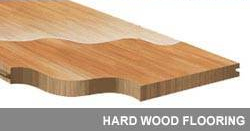
Most landlords have to endure the painstaking process of renovating an/or decorating their rental property at one point or another. Unfortunately, it’s often after a dirt-bag tenant has been escorted off the premises by a burly henchman that’s been summoned by the courts.
Once the aftermath of the tenants occupancy is assessed, from my experience, carpets are one of the most glaringly frightening sights, and that’s usually because they’re covered in urine and kebab juice.
So then the question emerges, carpet or laminate flooring, and which is the most practical choice for rental properties?
Laminate flooring has become the cornerstone of modern style for many residents; they’re an extremely demanded commodity. It’s not surprising- they’re cost-effective, they’re easy to maintain, and they have the potential to make an ordinary room standout with a bit of contemporary style. But a carpet looks cleaner, feels much more homely and is so much kinder to bear feet.
Difference between real hardwood flooring and laminate
Firstly, I think it’s important to distinguish the difference between hardwood flooring and laminate flooring. A lot of people don’t seem to appreciate the difference. In fact, many people think they’re the same thing. But I assure you, if your diminished vision and/or inexperience can’t spot the difference, the price difference between the two products will make it transparent how world’s apart they truly are.
Essentially, hardwood flooring is the Rolls-Royce, while laminate flooring would be lucky to be metaphorically compared to a Proton. Granted, that holds most true when boiled down to the technicalities, because these days laminate flooring often gets confused with hardwood flooring, which says a lot about how far the inferior, ugly sister has come. Of course, in both cases, once you switch the spotlights on, get down on your knees and examine the product, it’s clear what you’ve settled for.

Hardwood flooring
Solid hardwood floors are made of planks milled from a single piece of timber. Simply, they’re panels of real wood, designed to be used as flooring. Pretty straight forward and self-explanatory.

Laminate flooring
Laminate flooring is made to look just like traditional hardwood flooring but is, in fact, a thin layer of decor paper placed under a tough-as-nails protective film. Decor paper is actually a photographic image of a certain type of wood. This picture is then glued and pressed to a high-density backing board. Despite appearances there is no real wood in a laminate board at all.
For the average landlord, which is providing a tenancy in a low-to-mid range property, the debate should always be, “carpet or laminate?”, and that’s precisely why I’m restricting the battle between those two types of flooring. Hardwood flooring should not be spared on anything short of top-tier properties, demanding prices that will reduce a blue-collar worker into tears. For example, if your property is achieving £200 per month, then you’re going to get £200 pcm tenants- they won’t be expecting much in terms of decor, and they definitely won’t be expecting high-end fittings. But more importantly, hardwood flooring is an investment you’ll NEVER get a return on. Don’t bother.
However, before even putting yourself through the debate and splashing out on new carpets or laminate flooring, it might be worth checking underneath the existing rags. You might be surprised, there could already be quality flooring sleeping, untouched. Hardwood flooring only recently became “trendy” in the last decade, before that, homeowners were selling their kidneys to fund carpets so they could cover them up. It’s amusing how fashion trends swing around.
If lady luck is on your side (which it probably won’t be, but you never know), you may find a sleeping beauty that will require the kiss of life, in the form of sanding paper and a lick of varnish.
Carpet or Laminate flooring?
So… onto the crux of the matter.
From my experience, laminate flooring is the better option over carpet in rental properties, and here’s my reasoning…
- Laminate flooring is much more durable, which means it can withstand a lot more abuse than carpets. After a while, carpet will start to fray and show obvious signs of wear. It’s important to note, landlords cannot get compensation for fair wear and tear, and distressed carpets usually fall into that category.
- By nature, carpets are much more prone to attracting and clinging onto dirt, which means they get dirty quickly and need to be cleaned regularly. They require much more attention and maintenance.
- Laminate flooring is easy to clean, the process only requires a very moderately damp cloth and a sweep. For a thorough carpet clean, a specialist vacuum and shampoo is required, and they can often be expensive. Or at least more expensive than a bit of cloth and a sweeper.
- We all know from experience that when you start rearranging furniture in a room fitted with carpet, you start surfacing clean patches of carpet that was once protected by furniture. That’s when you’re left feeling sickened by how you’ve been living like a filthy animal, and didn’t even know it. It’s truly an awful moment, and brings you back to reality. That’s going to happen every time a tenant vacates with all his furniture. Try explaining that mess during a viewing to your new prospective tenants. It just doesn’t look good, and I’ve been in cases where tenants have used that as a bargaining tool.
However, with laminate flooring, that doesn’t happen.
- It’s a lot cheaper to repair laminate flooring. Typically, when carpet has been damaged, the entire room needs re-carpeting to resolve the problem, or at least a large portion of the area, unless you’re happy with the patchy-quilt look. But rest assured, even if you are content, your tenants won’t be. However, the beauty of laminate flooring is that it’s laid down in panels that clip together like a jigsaw, which means you only have to replace the panels that are damaged, and not the entire lot.
- In reality, the argument can be had that laminate flooring can be compared to premium carpets that are designed to withstand heavy treading and toxic carpet shampoos. While that is true (arguably), carpet of that quality is much more expensive per square foot than laminate flooring. But also, you’re still left with the problem mentioned in the above point.
So, there are my arguments for being pro laminate flooring over carpet. Although, I still do believe carpet has its merits, and I wouldn’t look-down on anyone swaying towards that direction. If you do go down the carpet route, avoid light colours. It’s extremely difficult to keep light carpets clean, and generally speaking, it’s work that most tenants won’t have any interest in participating in. Ultimately, applying a light colour palette is a sure-fire way to exhaust your funds on frequent replacements of carpet. I find that mid-toned browns and greys are most practical/durable. They don’t cast too much of a shadow (especially in rooms with access to natural lighting) and they’re neutral so they go with most other colours.
What are your thoughts? Do you have anymore arguments for being pro laminate that I can throw onto the list?
Disclaimer: I'm just a landlord blogger; I'm 100% not qualified to give legal or financial advice. I'm a doofus. Any information I share is my unqualified opinion, and should never be construed as professional legal or financial advice. You should definitely get advice from a qualified professional for any legal or financial matters. For more information, please read my full disclaimer.


 Landlord Products / Services
Landlord Products / Services



























Thank you. We are building a new home and having a tough time deciding carpet or wooden floors. I want wooden floors and my husband wants carpeting. Maybe we will have to go half and half.
Thank you,
Karen J. Fraleigh